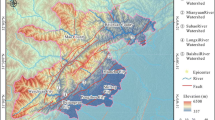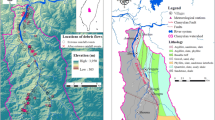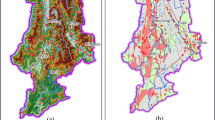Abstract
A rainfall-induced debris flow warning is implemented employing real-time rain gauge data. The pre-warning for the time of landslide triggering derives the threshold or critical rainfall from historical events involving regional rainfall patterns and geological conditions. In cases of debris flow, the time taken cumulative runoff, to yield abundant water for debris triggering, is an important index that needs monitoring. In gathered historical cases, rainfall time history data from the nearest rain gauge stations to debris-flow sites connected to debris flow are used to define relationships between the rainfall intensity and duration. The effects by which the regional rainfall patterns (antecedent rainfall, duration, intensity, cumulative rainfall) and geological settings combine together to trigger a debris-flow are analyzed for real-time monitoring. The analyses focused on 61 historical hazard events with the timing of debris flow initiation and rainfall duration to burst debris-flow characteristics recorded. A combination of averaged rainfall intensity and duration is a more practical index for debris-flow monitoring than critical or threshold rainfall intensity. Because, the outburst timing of debris flows correlates closely to the peak hourly rainfall and the forecasting of peak hourly rainfall reached in a meteorological event could be a valuable index for real-time debris-flow warning.














Similar content being viewed by others
References
Aleotti P (2004) A warning system for rainfall-induced shallow failures. Eng Geol 73:247–265
Caine N (1980) The rainfall intensity: duration control of shallow landslides and debris flows. Geogr Ann A Phys Geogr 62(1/2):23–27
Calcaterra D, Parise M, Palma B, Pelella L (2000) The influence of meteoric events in triggering shallow landslides in pyroclastic deposits of Campania, Italy. In: Proceedings 8th international symposium on landslides, Cardiff, pp 209–214
Campbell RH (1975) Soil slips, debris flows, and rainstorms in the Santa Monica Mountains and vicinity, Southern California. US Geological Survey Professional Paper no. 851, p 51
Cannon SH, Ellen SD (1985) Rainfall conditions for abundant debris avalanches, San Francisco Bay region. California Geol 38(12):267–272
Central Geologic Survey, MOEA. http://www.moeacgs.gov.tw/english/index.htm
Ceriain M, Lauzi S, Padovan N (1992) Rainfalls and landslides in the Alpine area of Lombardia region, central Alps, Italy. In: Proceedings of interpraevent, Bran, Switzerland, band 2, pp 9–20
Crosta G, Frattini P (2002) Rainfall thresholds for triggering soil slips and debris flow. In: Proceedings of the 2nd Plinius international conference on Mediterranean Storms, Siena, Italy
Dhakal AS, Sidle RC (2004) Distributed simulations of landslides for different rainfall conditions. Hydrological Processes 18:757–776
Glade T, Crozier M, Smith P (2000) Applying probability determination to refine landslide-triggering rainfall thresholds using an empirical “antecedent daily rainfall model”. Pure Appl Geophys 157:1059–1079
Guadagno FM (1991) Debris flows in the Campanian volcaniclastic soils (Southern Italy). In: Chandler RJ (ed) Proceedings of international conference on slope stability engineering. Isle of Wight, UK, pp 109–114
Hsu KL, Gao X, Sorooshian S (2002) Rainfall estimation using cloud texture classification mapping. In: Proceedings of international precipitation working group, 1st workshop, Madrid, Spain, 23–27 September, pp 1–5
Keefer DK, Wilson RC, Mark RK, Brabb EE, Brown WM III, Ellen SD, Harp EL, Wieczorek GF, Alger CS, Zatkin RS (1987) Real-time landslide warning during heavy rainfall. Science (New Series) 238(4829):921–925
Kidd C, Kniveton DR, Todd MC, Bellerby TM (2003) Satellite rainfall estimation using combined passive microwave and infrared algorithms. J Hydrometeorol 4:1088–1104
Wilson RC, Jayko AS (1997) Preliminary maps showing rainfall thresholds for debris-flow activity, San Francisco bay region, California. U. S. Geological Survey, Open-File Report 97–745 F
Acknowledgements
The authors would like to thank the National Science Council of the Republic of China, Taiwan for financially supporting this research under Contract No. NSC 92-2811-Z-002-007.
Author information
Authors and Affiliations
Corresponding author
Rights and permissions
About this article
Cite this article
Chien-Yuan, C., Tien-Chien, C., Fan-Chieh, Y. et al. Rainfall duration and debris-flow initiated studies for real-time monitoring. Environ Geol 47, 715–724 (2005). https://doi.org/10.1007/s00254-004-1203-0
Received:
Accepted:
Published:
Issue Date:
DOI: https://doi.org/10.1007/s00254-004-1203-0




